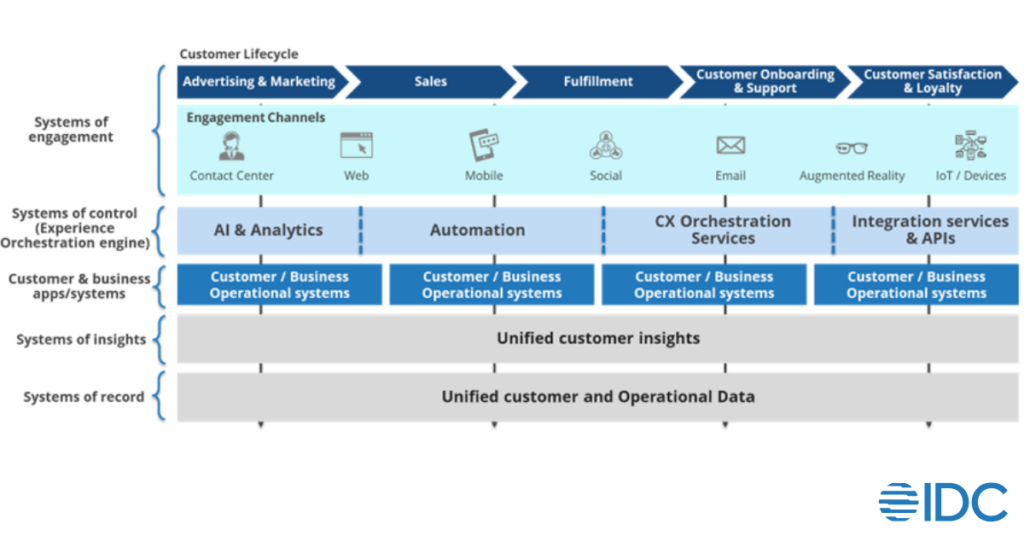IDC’s 2024 Customer Experience Management Strategies survey found that businesses globally have shifted to a focus on improving the effectiveness of their customer experience (CX) investments while driving profitable revenue growth.
IDC finds that C-suite priorities for customer experience are squarely focused on optimizing experience delivery, making experience consumption easy, and achieving experiential value parity. But achieving these directives requires organizations to rethink experience delivery as greater than just the sum of multi-channel, front-office interactions. When done right, IDC research shows that unified CX can lead to higher customer retention, improved advocacy and ultimately profitable revenue growth.
What does it mean to orchestrate unified experiences across the full lifecycle of customer outcomes?
IDC’s 2024 CX Path survey found that improving scale and consistency for orchestrating experiences across the enterprise was the #1 business driver for companies implementing customer experience orchestration solutions. To negotiate the complexity across channels, touchpoints, journeys, and systems/applications across functions, that deliver value-based outcomes based on changing customer context at every moment, organizations must adopt a multi-layered approach to CX delivery across all organizational layers, including middle and back-office functions. This involves integrating systems of record, insights, control, and engagement to ensure seamless and consistent customer interactions.

Systems of Record
Organizations need to address data fragmentation by unifying customer and operational data. This integration is crucial for scalable AI workloads and deeper customer insights. IDC’s 2024 CXMS survey found that only about 24% of organizations have access to a single source of customer data with full integration across the stack. By pooling data from front-office and back-office functions, companies can create a comprehensive view of the customer journey.
Systems of Insights
A cohesive fabric of customer insights is essential. Organizations should combine structured and unstructured data to generate actionable customer intelligence. Sharing and integrating these insights into daily operations can significantly improve customer engagement and business outcomes.
Systems of Control
The orchestration layer acts as the connective tissue, integrating various systems and ensuring real-time, context-aware customer engagement. This layer leverages AI and automation to manage workflows, business logic, and customer interactions, enhancing decision-making across the organization.
Systems of Engagement
This layer includes, but is not limited to, the various customer engagement channels across digital, physical, and blended, employee-facing tools and platforms that may be either exclusive or shared by both employees and customers, and various engagement channels through which 3rd parties engage with the brand. Organizations that isolate experience delivery to one stakeholder group will ultimately get left behind.
Where do AI Agents and Agentic systems fit into intelligent experience orchestration?
AI Agents are a route to deliver greater sophistication for unified experience orchestration. Data and computing power advancements and the availability of advanced reasoning models are driving more sophisticated, more advanced Agentic AI capabilities. Core characteristics of AI Agents make them optimally suited to address the gaps organizations must fill in order to deliver unified intelligent experience orchestration.
AI Agents all share the following core characteristics:
- Planning: AI agents can plan and sequence actions to achieve specific goals. Empowers Al to break down complex tasks into manageable steps, developing structured approaches to problem-solving. The integration of LLMs has revolutionized their planning capabilities.
- Perception: AI agents can perceive and process information from their environment, to make them more interactive and context aware. This information includes visual, auditory, and other sensory data.
- Tool usage: Advanced AI agents can use various tools, such as code execution, search, and computation capabilities, to perform tasks effectively. AI agents often use tools through function calling.
- Multi-Agent Collaboration: Facilitates multiple Al agents working together, each with specialized roles, to tackle complex problems more effectively.
- Memory: AI agents have the ability to remember past interactions (tool usage and perception) and behaviors (tool usage and planning). They store these experiences and even perform self-reflection to inform future actions. This memory component allows for continuity and improvement in agent performance over time.
This enables AI Agents to create a new layer of ‘intelligent actions’ on top of CX and business applications. AI Agents consume and hand off customer and operational data, insights, tasks, across systems, workstreams, processes, and business functions, in a continuous, context-aware, manner. A system of AI agents essentially functions as the glue / connective tissue that connects organizational functions, systems/applications (customer-facing, operational systems, and employee tools), and data. This offers organizations the needed automation and scale for seamless vertical integration through the multiple layers for unified experience orchestration.
With 35% of enterprises reporting that fulfillment aspects of the customer journey don’t extend beyond front-office processes, enterprises face a significant gap in orchestrating and delivering whole journey customer experiences. Agentic AI presents an equally significant opportunity to unlock machine scale, beyond just productivity gains to improve connectedness across the entire CX ecosystem with intelligence at the core.
AI Agents can even bridge gaps in the fragmented technology landscape at many organizations. However, harnessing value from Agentic AI for CX will require enterprises to address long-standing, foundational challenges such as customer and operational data integrity, unification, and governance, AI governance, and customer privacy/security. Crucially, organizations must prioritize approaches to address the workforce impact of GenAI and agentic technology capabilities up front, especially front-line employees, who will continue to remain an integral part of delivering excellent customer experiences.




